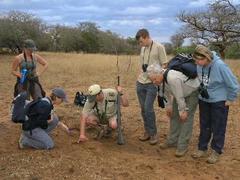
I wrote on this blog after my first week in South Africa, on why I am here and what I had seen in my first days in this country. It has now been five weeks since I arrived in East London, and after these weeks of cultural study and immersion, I am again looking at what it is that separates this country, and the African continent, from the rest of the world.
Africa as a continent has long been recognized for its scale: huge African skies; tall, far-reaching African grasses; large African cats and long-necked African giraffes: animals and lands worthy of exploration, study, discovery. To visit Africa has been marketed as an opportunity to leave the concrete maze of modern life and find something huge and real and wild, something that connects to the inner part of the soul which is constantly, quietly yearning for uncultivated earth and endless skies. People come to this continent to see what exists beyond office buildings, shopping malls and landscaped yards; they come to find the unconquered and unconquerable wilderness; and they come with the illusion that they will be the ones to conquer it.
These people look over East London. This city has shopping malls. It has paved roads and office buildings and landscaped yards and telephone wires and nine-to-five jobs and pigeons eating trash on sidewalks and KFC on the corner. But they don't understand that this is still Africa, that if you stop and breathe deeply, even in the middle of the city, you can feel the strength, resilience, and interconnectedness that is the unique essence of the continent. You can see it in the people: wherever they live and whoever they are, the people who live here all have Africa inside of them. As Vic Guhrs says in his book The Trouble With Africa, "The trouble with Africa is that once it is in your blood, like malaria, it is almost impossible to get rid of." South Africa has exemplified this concept in the whole of its history. People from all over the world have come to this country for their own reasons: missionaries from Germany, dockworkers from England, labourers from India, wives from Ireland, colonizers from the Netherlands -- and all of these have become Africans, just as the Xhosa and Zulu people are Africans. Instead of turning the country Dutch or English, the country turned them. You can only be in this place for so long before it adopts you as its own.
Though the city may disguise them, the big open spaces are here as well. Drive six kilometers to the beach and you’ll find yourself on giant cliffs embedded with ancient life, coated with recent life, crawling with new life, overlooking huge untamable waves crashing in from an endless blue ocean which, far in the distance, touches an equally endless, arching blue sky. Drive an hour inland through the dry, cow-spotted fields and you’ll find yourself suddenly surrounded by a thousand shades of green, climbing over immense moss-covered boulders beside towering waterfalls, staring toward ghostly canopies floating in a near-impenetrable mist, becoming engulfed by the hums and clicks and warbles and shrieks and croaks and drips and whoops that create the symphony of the forest, feeling small and foolish standing there with your worn tackies and half-filled pack and diminishing fantasy that you could conquer all this greatness, realizing the indifferent acceptance and quiet invitation that the land offers you and losing the feeling of self-importance with which you entered the forest. You may be an outsider now, it says, just as the people say, but you don't have to be one for long.






